Hideki Uchijima
(Kanazawa University Library)
● Introduction
On December 3 and 4 2009 the Digital Repository Federation International Conference (DRFIC 2009) was held. This paper is a brief overview of the conference.
● Digital Repository Federation
Digital Repository Federation (DRF) is a collaborative program of Cyber Science Infrastructure (CSI), which was started by Hokkaido University Library, Chiba University Library and Kanazawa University Library in 2005, supported by National Institute of Infomatics (NII) with the aim of promoting cooperation among those who manage institutional repositories (IR). Although DRF is named ‘Federation’ it does not have any membership rules but operates voluntarily in the loosely-organized way for mutual supports among members. The 87 universities and research institutes (as of January 2010) willingly joined DRF and now they are proactively engaged in its activities, giving direct or indirect supports.
DRF uses mailing lists and Wiki to exchange/share information about IR operation and open access, offering various styles of workshops and conferences in different areas. On the past events of DRF you can see in the following reports:
http://drf.lib.hokudai.ac.jp/drf/index.php?Digital%20Repository%20Federation(Japanese)
http://drf.lib.hokudai.ac.jp/drf/index.php?Digital%20Repository%20Federation%20%28in%20English%29(English)
● DRFIC 2008
In January 2008 Digital Repository Federation International Conference 2008 was held. It was the first international conference of DRF and DRFIC 2009 is the second one.
Co-organized by Osaka University Library, National Institute of Infomatics, University Library Kinki Initiative, and the research group for “Reengineering of the Functionality of Research Libraries in the Digital Milieu (REFORM, of which the leader is Syun Tutiya, Chiba University.), and sponsored by the Ministry of Education, Culture, Sports, Science and Technology, DRFIC 2008 was held at Icho Kaikan, Alumnus Union Building for Osaka University Medical School. We had about 200 participants who were librarians, publishers and researchers. The medium language was only English, which was rare to “international” conferences by/for university librarians in Japan. The following is the detailed report of the conference.
http://www.tulips.tsukuba.ac.jp/DRFIC2008/index_ja.php( DRFIC2008)
● The Overview of DRFIC 2009
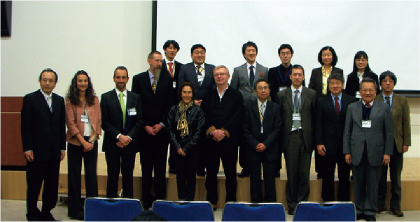 Grope Photo of the Chairs and the Speakers Grope Photo of the Chairs and the Speakers
DRFIC 2009 was held at Kuramae Hall, the brand-new building of Tokyo Institute of Technology, collaborated with SPARC Japan and Tokyo Institute of Technology Library and supported by SPARC, the Ministry of Education, Culture, Sports, Science and Technology, the Japanese Coordination Committee for University Libraries, the Japan Association of National University Libraries, the Public University Library Association and the Japan Association of Private University Libraries. SPARC Japan was a project launched by NII for the purpose of strengthening the electronic journals of Japan’s academic societies to internationally disseminate the research outputs. In 2010 the third term of the project starts with the policy of “promoting open access” in which academic societies and libraries are expected to work as two wheels of one cart running toward the goal of Japanese-styled open access networks.
The planning of DRFIC 2009 was done by the steering committee consisted of university librarians who manage IRs. The chair of the committee was Prof. Syun Tutiya (Chiba University), and the vice-chair was Prof. Masamitsu Kuriyama (Tokiwa University). The Library of Tokyo Institute of Technology and six other university libraries in the Tokyo metropolitan area set up the local organizing committee to conduct major works at the venue.
The number of participants was 174 coming from 8 countries, of whom 8 persons were foreigners including guest speakers, 166 were Japanese.
The theme of DRFIC 2009 was “Open Access Repositories now and in the future –from the global and Asia-Pacific points of view”. Our aim was not limited only to IR but also the open access movement in wider perspective and looking at the challenge of Japan and Asia from the global viewpoints as well as understanding the worldwide movement from Asian viewpoint.
The conference consisted of two keynotes, three sessions and a poster session. The medium language was English only as it was so in DRFIC 2008.
Opening keynote was given by Prof. Syun Tutiya, the chair of steering committee and the title of his speech was “What now?: Beyond publishing and libraries”.
The theme of Session 1 was “Coming of age and beyond: eScience, eResearch and ePublishing”. This session was chaired by Prof. Tutiya. The speakers were Dr. Salvatore Mele (CERN), Ms. Alicia López Medina (Universidad Nacional de Educación a Distancia) and Dr. David Shulenburger (Vice-president, Association of Public and Land-grant Universities). All of them were invited guest speakers.
The theme of Session 2 was “IR in Asia and the Pacific: Present and Future”. This session was chaired by Prof. Hiroya Takeuchi (Chiba University). The speakers were Mr. Peter Sefton (University of Southern Queensland), Dr. Simon C. Lin, Ya-Ning Chen (Adademia Sinica) and I, Hideki Uchijima. We were all invited guest speakers, too.
The theme of Session 3 was “Attitudes towards diversity”. This session was chaired by Prof. Masamitsu Kuriyama, the vice-chair of the steering committee. The speakers were Ms. Susan Gibbons (University of Rochester), Mr. Simon Bevan (Cranfield University), Mr. David Palmer (University of Hong Kong), Mr. Sho Sato (University of Tsukuba), Ms. Masako Suzuki (Otaru University of Commerce Library) and Ms. Mikiko Tanifuji (National Institute for Materials Science). Ms. Gibbons and Mr. Bevan were invited guest speakers.
Closing keynote was given by Prof. Jun Adachi (National Institute of Infomatics and SPARC Japan) and his speech title was “A Retrospective of NII Projects on New Perspectives in CSI”.
● Abstracts of Sessions
1. Opening Keynote
In opening Keynote Prof. Shun Tutiya overviewed the past 5 years of IR development in Japan and regarded it as a success in both skyrocketing growth of the number of IR and enhanced activities of librarians. But he pointed out that faculty/researcher awareness was still low as it was so in other countries. He said that more stress should be put on international collaboration for building up worldwide infrastructure and on roles of humanity researchers.
2. Session 1
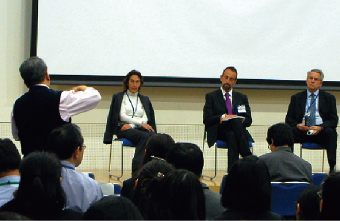 The Speakers of Session 1 answering questions The Speakers of Session 1 answering questions
Dr. Salvatore Mele had a presentation with the title of “Scholarly Communication in High Energy Physics: Repositories and Open Access”.
He summarized the present situation of open access in high energy physics and explained his observation in the following four points; tradition, tools, advantages and publishing. Open access tradition meant preprint culture of which good examples was SLAC Library (Stanford University) and SPRIES, the first electronic catalogue. About open access tools, he mentioned arXiv.org. As to open access advantages he told that citation rates greatly increased by the introduction of preprint server and emphasized the facts that citation peak came before publication and that 20% of 2-year citations occurred before publication. About open access publishing he referred to SCOAP3, an initiative in high energy physics, to which many consortia and research funding bodies would willingly join. For the success of SCOAP3 Japanese library community was said to be one of the most important stakeholders.
The title of Ms. Alicia López Medina’s presentation was “A Data Infrastructure for a Data oriented Research and Education”. Ms. Medina pointed out that the role of digital repositories has been changing and that institutional repositories should be transformed from document centered to data oriented. Data oriented IR would be infrastructures for virtual research communities of scientists to share scientific information exchanged through grid networks. In Europe some projects for E-Sicence including 4SCIENCE have been launched with grant funding under the Seventh Framework Programme of the European Community for research, technological development and demonstration activities. IR is a tool for the aim of those projects. Given an IR interoperably used as a unit of information networks in virtual research communities, our future tasks would be interoprerable persistent identifier, semantics and objects interoperability/open exchange and reuse (OAI-ORE). Finally the Confederation of Open Access Repositories (COAR), which was started in October 2009, was introduced.
Dr. David Shulengurger’s presentation was on “The Critical Role of Repositories in Advancing Research Findings”. He reflected on the repository called NEAR established in 1990’s on his own idea to cover scientific outputs and told that NEAR came into being thanks to the aid from government bodies and funding bodies (and their policies) such as NIH and Welcome Trust. However such repositories cover only limited fields like medicine and biology. So it is desirable for institutional repositories to adopt an open access mandate completely and to require researchers deposit their research outputs. In the United States Havard University and MIT adopted an open access mandate and they made great influence on other universities or academic journals. Another point to keep in mind here is that public access, which permits a certain term of embargo is more likely to coexist well with peer review function of academic journals. Researches undertaken in universities are invisible from taxpayers outside university and if all of their outputs become open to the public under an open access mandate the merit of visibility would increase greatly. In conclusion he expressed his hope for universities of all over the world including Asia and Japan would adopt an open access mandate and self-archiving of research outputs.
3. Session 2
Mr. Peter Sefton had a presentation with the title of “Suggestions for Asian/Australasian regional cooperation based on a critical evaluation of collaboration and standardization across Australian Institutional Repositories”. In Australia, IRs have been established in all 39 universities as the results of government supports and its granted projects such as ARROW and so on. The major functions of IR in Australia are open access to research, reporting to the Australian government on research outputs, showcasing an institution’s research and preservation of digital content. Based on Australian experience Mr. Sefton made some suggestions on data migration, government support, collaboration beyond different IR software, providing forums for community, necessity of soft wares that can handle multiple metadata schemas.
Dr. Simon C. Lin talked about “Future Perspectives of Institutional Repositories in Taiwan”.
He summarized the present state of IRs in Taiwan from the following points of views; digital archives, repositories, e-Infrastructure and a content Management system (CMS). In Taiwan, Taiwan e-Learning and Digital Archives Program (TELDAP) has been implemented for six years. TELDAP was separated in two different programs, National Digital Archive Program (NDAP) and e-Learning National Program (ELNP). Under these programs with US$ 500 million dollar budget various contents of different subjects have been digitalized and presently more than two million full-texts are publicly open. As to electronic journals, under SDOS project a mirror site of electronic journals Elsevier has been running since 1995, hosting a dark archive service for libraries in Taiwan covering 2,330 journals, 3,954,761 articles.
IRs project started in 2006 funded by Ministry of Education and 95 university libraries joined using the improved Dspace.
In the case of e-Infrastructure what is important is that scientific paradigm has been evolving historically. It shifted from experimental science to theoretical and computer science. And now data centered e-Science is the new paradigm. In Taiwan, Asia and Oceania regions, some grid networks like TWGrid and EUAsiaGrid has been working as useful e-Science infrastructure.
The author (Hideki Uchijima)’ presentation was on “Before & After DRF Initiative: a cluster of institutional repository programs beyond the traditional role of the library”. The CSI project by NII has been implemented in two divided areas. In area 1 the projects which support IR management and operation at individual institutions and in area 2 the research and development projects have been in place. Throughout all the projects in both areas provided a loose-knit supportive environment in which the networks of personal and corporate ties have grown.
4. Session 3
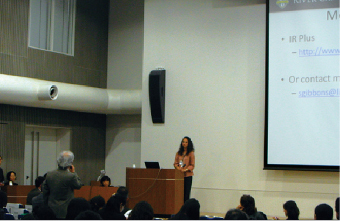 Ms. Susan Gibbons answering questions
Ms. Susan Gibbons answering questions
Ms. Susan Gibbons made a presentation with the title of “Studying Users to Design a Better Repository”. She talked about the process in designing the well known “Researcher Pages” as an additional function to Dspace at University of Rochester. They studied researchers’ needs with anthropological and ethnographic methods and developed the researcher pages. It is a customized functionality of documentation and preservation for researchers. University of Rochester further enhanced the functions of researcher pages and developed an open source called IR+.
Mr. Simon Bevan spoke on “Advocacy, content acquisition and the place of the repository in the research process”. At Clanfield University IR was established in 2003 with DSpace of its platform. However the submission rate scored poorly and the uptake of self-archiving was very slow. Thus the Embed Project was launched with grant in aid of Joint Information systems Committee (JISC). Its theme was to bring about cultural change in researchers’ behaviors. Media campaign from both directions of top down and bottom up was operated and wide community building was done by library staff’s positive involvements. The submission rate has greatly increased since 2007 as the result of the project. In United Kingdom Research Excellence Framework (RAF) is going to be measured and at Clanfield University IR will be incorporated in researcher information system.
Mr. Sho Sato made a presentation with the title of “RePEc’s impact on the use of working papers in institutional repositories”. He showed the analysis on downloads of working papers registered in two institutional repositories, which are of Institute of Developing Economics Japan External Trade Organization (IDE-JETRO) and of Hitotsubashi University (HERMES-IR), and one subject repository, Research Papers in Economics (RePEc). From the comparison of the numbers of downloaded working papers in these two IRs and RePEc Mr. Sato drew the conclusion that the high rate of downloading of the contents of two IRs was seen just after they had been registered with RePEc. The analysis proved that registration with subject repository has a strong impact on researchers in economics.
Ms. Masako Suzuki of Otaru University of Commerce Library talked about “A polynomial-expansion approach to IR and ILLD”. According to her analysis on the past three years of the duplicated materials in NACSIS-ILL there was no remarkable change in titles demanded and almost the same tendency continued. Many of the materials demanded are on nursing and most of them are not available on the Internet. She pointed out that it is important that the needs of photocopy duplication for the papers should be informed to the authors to motivate them to self-archive their research results and to deposit them to their IRs.
Ms. Mikiko Tanifuji made a presentation with the title of “e-Science Experiences in NIMS eSciDoc: Self-archiving of profiled experimental data”. National Institute for Materials Science (NIMS) has advanced toward eScience infrastructure by developing systems including “FACES” on eScieDoc, the platform of IR and image data repository with the cooperation of FedoraCommons.
Mr. David Palmer of the University of Hong Kong spoke on “ResearcherPages: Author Buy-in to Institutional Goals”. He introduced the researcher pages in IR which the university requires all of the researchers to join for knowledge transfer. This researcher page is equipped with the various functions such as importing updated citation counts in data bases like Scopus.
5. Poster session
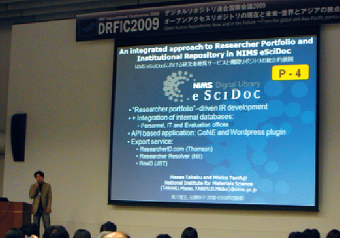 Poster session (NIMS) Poster session (NIMS)
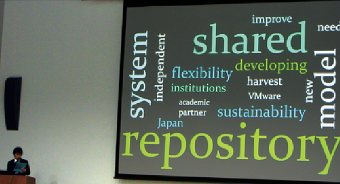 Poster session (SheRe) Poster session (SheRe)
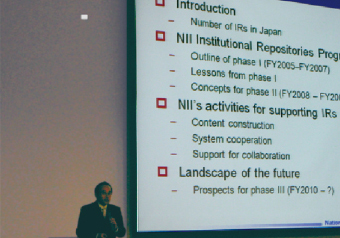 Prof. Adachi giving closing keynote Prof. Adachi giving closing keynote
There were 17 entries in total, 14 from universities and 3 from research institutes. Presented posters are laid open in the site below. At the completion of all the poster presentations the award ceremony was held and the posters of Mr. Ikejiri (Chiba University) and Dr. Sato (University of Tsukuba) were chosen as the best posters.
6. Closing Keynote
Closing keynote was given by Prof. Jun Adachi of SPARC Japan (National Institute of Informatics) with the title of “A Retrospective of NII Projects on New Perspectives in CSI”. He mentioned that installation of IRs in Japan rapidly expanded with the support of Cyber Science Infrastructure (CSI) and the 154 institutions have repositories including regional shared ones. He pointed out that the nation-wide system of scholarly information distribution has been built up with data bases such as CiNii, JAIRO, NII-ELS, J-STAGE, IR and KAKEN. He also referred as our future challenges to necessity for increasing number of institutions with IRs and possibility for mandating researchers to deposit research outputs of grants-in-aid researches.
See the following site for the conference documents:
http://drf.lib.hokudai.ac.jp/drf/index.php?DRFIC2009#qcdfdd88
In the end I would like to express my gratitude representing the steering committee to the members of the local organizing committee and the staffs of Tokyo Institute of Technology Library, who conducted DRFIC 2009 and to National Institute of Infomatics and SPARC for their financial supports.
2010 January 22
|

